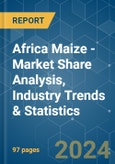Maize is considered to be the staple food for most parts of Sub-Saharan Africa. The popularity and production of maize are increasing significantly, with government aid and investments flooding the African agriculture sector. Maize is also considered a food security crop in different parts of Africa as it can be easily produced in different regions year-round according to weather conditions. It provides income for most households that depend on agriculture. The major driving factors for the increasing production are the increasing population pushing food scarcity to new highs and the increasing demand for maize from other sectors like animal feed.
Africa consumes 30.0% of the maize produced in the world, with Sub-Saharan Africa accounting for 21.0% of the consumption. Around 14 countries in Africa consume 85.0-95.0% of maize as their staple food and are more inclined to white maize consumption, with a consumption share of around 90.0%. Thus, white maize has a premium price in the country. Most of the maize is produced in rain-fed areas. However, it is also grown in the drought and famine-stricken regions of Africa.
The total harvested area under maize in the region was around 43 million hectares in 2020. South Africa is the largest producer of maize in Africa, followed by Nigeria. According to USDA reports, maize production in Africa increased by almost 8.2% from 2017 to 2022, estimated to be 90.8 million metric tons. In 2021, South Africa contributed 1.34% of the global maize production, according to a survey done by USDA Foreign Agricultural Service.
The imports from Africa increased by 10.% in value from 2017 to 2021 and reached USD 5.17 million, accounting for 8.6% of the total import value of maize in the world, according to ITC trade data. South Africa is one of the major exporters of maize from the African region, accounting for almost 75% of the export quantity in 2021, estimated to be 3.32 million metric tons, followed by Tanzania, Mali, and Zambia, among others.
Africa Maize Market Trends
Increasing Demand from the Animal Feed Industry
With its nutritional values, ease of production, and availability, maize is becoming an important alternative to the animal feed industry. Cereals are the most widely used ingredient in feeds across the world, including Africa. Maize is the most common cereal ingredient used in the manufacturing of feed in the region. The increasing cattle population is leading to the demand for animal feed production. According to Alltech Global Feed Survey, in 2021, a total of 44.2 million metric tons of feed was produced in the African region alone, a 2.4% growth from the previous year. The broiler feed production reached 11.7 million metric tons in 2021, a 1.1 % growth from the previous year, and the aquaculture feed production also saw an increase in the same period, reaching 1.49 million metric tons.As maize is the major ingredient used in feed manufacturing, the demand for maize production is increasing. According to FAO, total cattle stocks increased to 8.1% in 2020 compared to 2017. Maize as a feed ingredient can increase egg production in poultry and meat mass in other animals. With low cost and easy availability, maize has become one of the best alternatives for producing animal feed with adequate nutrients. Yellow corn is one of the most widely used primary ingredients for animal feeds. In South Africa, around 65% of the maize produced is white, and the rest, 35%, is yellow maize used for animal feed. In the case of Uganda, 37% of the maize produced is used for animal feed.
Approximately 60% of the maize produced globally is used for animal feed, and the sudden increase in the consumption of poultry in Africa has increased the demand for maize as livestock feed. This, in turn, has stimulated the demand for maize as a feed ingredient in the region.
South Africa dominates the Market
South Africa is the largest and most active producer of maize in Africa. South Africa has a relatively dry climate that contributes to a unique hardness and whiteness, which is of great importance to the milling industry. Hard maize ensures a higher-quality product and yield per ton, while whiteness is of importance to the consumer market. In South Africa, approximately 65.0% of the maize produced for human consumption is white, whereas the remaining 35.0% is yellow and used for animal feed.However, maize production in the region is being continuously and severely affected by threats, such as weeds, insects, bacteria, viruses, nematodes, fungi, low-quality seed, low levels of mechanization, suboptimal post-harvest management, drought, and climate change. Despite all these factors, South Africa remains the top maize-producing country in the region, with the demand expected to increase during the forecast period.
Africa Maize Industry Overview
Additional Benefits:
- The market estimate (ME) sheet in Excel format
- 3 months of analyst support
This product will be delivered within 2 business days.
Table of Contents
Methodology

LOADING...










